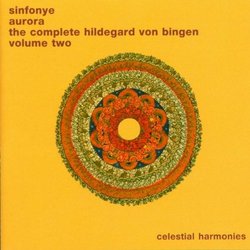| All Artists: Sinfonye, Stevie Wishart Title: The Complete Hildegard von Bingen, Volume Two: Aurora Members Wishing: 1 Total Copies: 0 Label: Celestial Harmonies Release Date: 7/2/1997 Genre: Classical Style: Number of Discs: 1 SwapaCD Credits: 1 UPC: 013711312829 |
Search - Sinfonye, Stevie Wishart :: The Complete Hildegard von Bingen, Volume Two: Aurora
 | Sinfonye, Stevie Wishart The Complete Hildegard von Bingen, Volume Two: Aurora Genre: Classical
This is the second volume of The Complete Hildegard von Bingen. Hildegard von Bingen (1098-1179) was born the tenth child to a noble family and was dedicated at birth to the church. At age three she began to have vision... more » |
Larger Image |
CD Details
Synopsis
Album Description
This is the second volume of The Complete Hildegard von Bingen. Hildegard von Bingen (1098-1179) was born the tenth child to a noble family and was dedicated at birth to the church. At age three she began to have visions of luminous objects, but soon realized she was unique in this ability and kept these visions secret for many years. Hildegard's religious education, which began at the age of eight, consisted of an ascetic life of prayer and contemplation. At a time when few women were accorded respect, she lived to become a highly respected writer, poet, composer and visionary sought after for her counsel by bishops, popes and kings.Images of aurora or dawn appear in many of Hildegard's songs as metaphors for the Virgin Mary and is implicit as the inner and outer energy in all virgins. This recording freely gathers those songs inspired by the young saint Ursula, the Virgin Mary, and the expressive spirituality of Hildegard's nuns. The songs are a celebration of virginity, but also would have been part of the general medieval belief that music had its own spiritual power, and that given the right conditions, could be heavenly. It was the music of virgins that Hildegard heard as celestial harmony.Virgins and widows represent the two groups of women in Hildegard's community. Perhaps these unique and difficult songs were composed specially for her nuns as a more personal expression of their devotional life rather than for use in church. This, the second volume ends with O pater omnium, which is more somber than the exultant love lyrics of the virgins as brides of Christ. Here the language of love is more devout, its melody more poignant and the songs create a spiritual atmosphere that lingers beyond the distance of centuries.

 Track Listings (15) - Disc #1
Track Listings (15) - Disc #1